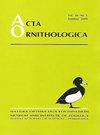阿根廷特有和受威胁的亚马逊土库曼的摄食生态和主要食物资源
IF 1.3
4区 生物学
Q3 ORNITHOLOGY
引用次数: 4
摘要
摘要食物资源的可用性调节了几种鹦鹉的种群水平和繁殖成功率。在新热带地区59种受威胁的鹦鹉中,只有34种可以获得有关饮食的信息。不可持续的森林管理可能会使树木失去种子和果实,而种子和果实是鹦鹉的主要食物资源。亚马逊图库曼鹦鹉是一种特有的濒危鹦鹉,被归类为易危鹦鹉,只出现在阿根廷西北部和玻利维亚南部的安第斯山地森林中;即南云加斯。确定了图库曼亚马逊的饮食、食物供应、专业化、关键食物资源以及食物资源的季节和空间变化。2007年12月至2009年2月,在El Rey国家公园记录了图库曼亚马逊的喂食情况。在云雾林(高海拔湿润森林)和过渡林(位于山前的半熟森林)的酚学地块中,评估了图库曼亚马逊可以用作粮食资源的带种子、果实或花朵的树木的可用性。这两种类型的森林在图库曼亚马逊地区的粮食资源可用性方面都表现出显著的季节性。这一物种中,有66%是靠种子喂养的。帕拉托雷波德ocarpus parlatorei是图库曼亚马逊在云雾林繁殖期和过渡林非繁殖期使用最广泛的树种。由于其种子和果实中的高脂肪和高油脂含量,帕拉托雷波德ocarpus parlatorei可能对图库曼亚马逊小鸡的发育至关重要。图库曼亚马逊在非繁殖期使用的食物树种少于繁殖期,表明食物资源的专业化程度更高(即生态位宽度更窄)。为了确保P.parlatorei和A.visco果实的生产,南云加斯的可持续森林管理应为图库曼亚马逊保留足够的这些关键资源。本文章由计算机程序翻译,如有差异,请以英文原文为准。
Feeding Ecology and Key Food Resources for the Endemic and Threatened Tucuman Amazon Amazona tucumana in Argentina
Abstract. Food resource availability regulates population levels and reproductive success in several parrot species. Of the 59 threatened parrot species in the Neotropics, information on diet is available for only 34. Unsustainable forest management can eliminate trees with seeds and fruits that are key food resources for parrots. Tucuman Amazon Amazona tucumana is an endemic and threatened parrot species categorized as Vulnerable that occurs only in Andean montane forests of northwestern Argentina and southern Bolivia; i.e., the Southern Yungas. The diet of Tucuman Amazon, food availability, specialization, key food resources, and seasonal and spatial variation of food resources were determined. Feeding bouts of Tucuman Amazon were recorded from December 2007 to February 2009 in El Rey National Park. Availability of trees with seeds, fruits or flowers that could be used by Tucuman Amazon as food resources was assessed in phenology plots in cloud forest (high elevation humid forest) and transition forest (semideciduous forest located in the piedmont). Both forest types showed marked seasonality in availability of food resources for Tucuman Amazon. Sixty-six percent of this species feeding bouts were on seeds. Podocarpus parlatorei is the most widely used tree species by Tucuman Amazon in the cloud forest during the reproductive period and Acacia visco in the transition forest in the non-reproductive period. Podocarpus parlatorei could be critical for the development of Tucuman Amazon chicks, due to the high fat and oil content of its seeds and fruits. Tucuman Amazon used fewer food tree species during the non-reproductive than the reproductive period, showing a greater specialization of food resources (i.e., narrower niche breadth). To ensure the production of fruits of P. parlatorei and A. visco, sustainable forest management in the Southern Yungas should retain an adequate level of these key resources for Tucuman Amazon.
求助全文
通过发布文献求助,成功后即可免费获取论文全文。
去求助
来源期刊

Acta Ornithologica
生物-鸟类学
CiteScore
2.10
自引率
0.00%
发文量
14
审稿时长
>12 weeks
期刊介绍:
Publishes scientific papers (original research reports, reviews, short notes, etc.) and announcements from all fields of ornithology. All manuscripts are peer-reviewed.
Established in 1933 as Acta Ornithologica Musei Zoologici Polonici, since 1953 continued under the present title.
Published twice a year by the Natura Optima Dux Foundation under the auspices of the Museum and Institute of Zoology, Polish Academy of Sciences.
 求助内容:
求助内容: 应助结果提醒方式:
应助结果提醒方式:


